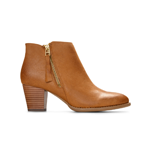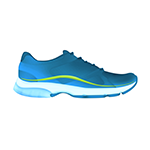
How To Elevate Your Walk & Find The Best Shoes For Power Walking
 How does your body feel when you power walk? Are your strides interrupted by nagging
joint pain that you can’t seem to get rid of, no matter how much you stretch? The problem may have an easy
solution:
How does your body feel when you power walk? Are your strides interrupted by nagging
joint pain that you can’t seem to get rid of, no matter how much you stretch? The problem may have an easy
solution:
Try different shoes.
Your shoes can have a major impact on your body, so picking the right ones can elevate your walking experience and help you achieve your fitness goals with confidence. Let’s explore how to pick the best power walking shoes for you.
What is Power Walking?
Before we power into finding the best walking sneakers, we must answer the obvious question: what even is power walking? Is it really any different from regular walking?
In a word, yes.
Walking is usually done at a leisurely pace, but power walking focuses on speed. While power walking is faster than a regular walking pace, one foot is always on the ground, differentiating it from jogging.
Power walking is a vigorous exercise accessible to many people without requiring special equipment, gym memberships, or experienced fitness levels. Plus, incorporating power walking into your daily routine can support both your physical and mental well-being.
The Many Health Benefits of Power Walking
Power walking may not seem as strenuous as other aerobic workouts like running, swimming, or cycling, but it provides an array of potential health benefits that can boost your well-being.
Some of the many potential areas that power walking can support are:
- Cardiovascular health – Power walking can improve blood circulation, lower blood pressure, regulate cholesterol levels, and even reduce the risk of heart disease. Increased circulation helps your blood deliver oxygen and nutrients throughout the body to keep your muscles in tip-top shape, too.
- Injury recovery – Power walking is a low-impact exercise, meaning it’s gentle on your joints while building muscle strength. This makes power walking an ideal exercise for people recovering from injuries who still want to get their daily exercise in.
- Bones, muscles, and joints – Power walking can soothe joint pain from conditions like arthritis as it has been shown to strengthen your muscles, ease the joints to reduce stiffness, and improve your flexibility and balance.
- Mental health – Exercising releases brain chemicals called endorphins, which may help relieve symptoms of anxiety and depression. Brisk walking may improve mood and brain function, potentially boosting memory, focus, and problem-solving skills.
Additionally, one study even showed how walking for an hour each week may help prevent mobility disabilities in adults with lower extremity joint symptoms.
Understanding the Importance of Proper Footwear for Power Walking
Power walking does wonders for your health, so investing in a proper pair of walking shoes is crucial to maximizing the benefits of power walking.
Choosing shoes designed for more strenuous and longer-distance walking is essential for anyone interested in a power-walking routine. Walking shoes are designed to provide your powerful strides with support where your feet and gait need them. The right shoes can help prevent injury, calluses, and blisters—while simultaneously fueling your every step.
Key Features to Look for in Power Walking Shoes
Proper power walking shoes should enhance your walking experience, not act as a detriment. Your footwear should be comfortable, alleviate excess strain from your joints, and stabilize your walking gait.
To maximize these qualities, look for these key features in power walking shoes:
- Cushioning – Every step you take puts force on your feet and joints. Shoes with extra cushioning provide shock absorption that helps redistribute that force, alleviating some of the impact as your foot hits the ground. Shock-absorbing qualities can reduce the risk of injury, fatigue, and unnecessary foot pain, keeping your feet comfortable for long periods.
- Ample arch support – Leg or gait misalignment can be a primary reason for knee, ankle, and lower back pain. Arch support can correct issues like flat feet or high arches to properly align the legs and remove excess pressure on other areas of the body that cause joint aches and pains.
- Flexibility – Flexible walking shoes should bend with your natural walking gait. Greater flexibility allows a superior range of motion and an easier push-off with each step.
- Traction – Your footwear should have ample traction to provide balance on different types of terrain you may encounter while walking. Shoes with poor traction may cause you to slip and fall on uneven surfaces, leading to injury.
- Breathable materials – Shoes with lightweight materials like suede, mesh, knit, and polyester allow airflow so your feet can breathe. Breathability is essential in keeping your feet cool and comfortable during walks and may help with odor control.
Each shoe features different qualities to accommodate all types of walkers and their needs.
Exploring Different Types of Power Walking Shoes
To discover the footwear that fits your foot health needs, explore the different types of power walk shoes that focus on specific areas of support.
Cushioned Shoes
Walking shoes with extra cushioning are ideal for those with high arches, also referred to as underpronated or supinated feet. If your arches are supinated, it means your feet roll outwards whenever you take a step.
Extra cushioned shoes provide:
- Comfort for all-day use
- Additional shock absorption
- High insoles to take the pressure off the outside and balls of your feet
Ample shoe cushioning may also supply pain relief from conditions like bunions, arthritis, and plantar fasciitis.
Stability Shoes
Stability shoes are a method of gait alignment, especially beneficial for people with normal arches or overpronation (flat feet). Gait misalignment occurs when you take a step, and your ankles roll inward, often causing knee and joint pain. But with proper stability or recovery shoes, you can correct your arches.
Stability shoes correct this issue with features like:
- Arch support
- Firm orthotic insoles
- Rigid structure
These key features promote leg realignment and keep the feet steady.
Motion Control Shoes
Motion-controlled shoes are a stricter method of gait alignment designed for severe overpronation. Motion-controlled shoes include similar features to stability shoes but have a few key differences:
- Extra heel cup support
- They are less flexible than stability shoes
- They may be heavier than a traditional shoe
If you have neutral arches, motion-controlled shoes may feel too stiff for comfortable wear.
Choosing Between Cushioning and Support: What’s Best for You?
With a variety of walking shoes, it can be hard to pick what type of footwear will be right for you. To choose what shoe will best support your feet, determine what type of arch you have.
A quick and easy way to do this is by making a footprint:
- Wet the bottom of your feet.
- Step onto a piece of paper, cardboard, or concrete.
- Observe the print left behind.
As you look at your footprint, examine your arches and the balls of your feet.
Neutral Arch
If the middle part of your foot is half-filled, you have a neutral or medium arch. This is the most common arch type and means your body weight is evenly supported and your feet roll, or pronate, as they should.
If you have a neutral arch, you may benefit from flexible shoes or stability shoes with moderate cushioning and arch support. Try a neutral shoe like the Walker Sneakers, the made-over classic design featuring forefront flexibility, cushioning, and improved traction.
Flat Arch
If your footprint is nearly filled in, you have flat or overpronated arches. To minimize excess stress on your body, try stability shoes that will support your arches and realign your legs.
You may find extra comfort in a walking shoe like the Walk Strider Sneaker, which offers anti-roll technology, lateral rigidity constructs, and a stabilizer in the heel to minimize foot movement to prevent injury.
High Arch
If your footprint only shows the balls of your feet and your heels, you likely have high or supinated arches.
If this is the case, cushioned shoes may be your best choice. Try a shoe that will realign your feet to redistribute even pressure on your joints like the Walk Max Lace Up Sneaker. This sneaker balances max cushioning with full underfoot arch support and a deep heel cup to optimize your foot position.
Finding the Right Fit: Sizing and Comfort Considerations
Making sure your power walking shoe of choice is comfortable and fits properly matters just as much as the shoe type. To ensure maximum foot comfort, follow these tips as you select your perfect power walking shoes:
- Measure the length of your foot by tracing it on paper to guarantee an accurate fit.
- Leave about a thumb’s width of space between your big toe and the tip of the shoe to ensure a snug but not tight fit during activity.
- Your shoes should feel comfortable when you put them on. If you feel like you have to “break them in,” then they’re not the right shoe.
- Walk around in the shoes after you try them on to test if they rub, chafe, or slide while you move.
Investing in supportive, comfortable, and properly fitting shoes prioritizes your foot and joint health and sets you up for a successful fitness routine.
Elevate Your Power Walk with Vionic
Wearing the right walking shoes has a bigger impact than you might expect. Proper footwear allows you to power walk with confidence—opening up your day to a host of potential physical and mental benefits (and having a great time doing it).
Find your perfect power walking shoe at Vionic.
Our expertly designed shoes utilize bio-mechanics to prioritize both comfort and style, allowing you sweet relief for every power walking and wellness routine. Explore our expansive catalog from walking shoes to sandals, because everyone deserves to feel good on their feet.
Sources:
AJPM. One Hour a Week: Moving to Prevent Disability in Adults With Lower Extremity Joint Symptoms. https://www.ajpmonline.org/article/S0749-3797(19)30045-5/abstract
Cleveland Clinic. Gait Disorders and Abnormalities. https://my.clevelandclinic.org/health/diseases/21092-gait-disorders
Cleveland Clinic. Overpronation. https://my.clevelandclinic.org/health/diseases/22474-overpronation
Dynamic Foot and Ankle Center. What are Misaligned Feet? https://www.dynamicfootandanklecenter.com/what-are-misaligned-feet/
Harvard Health Publishing. Need a quick brain boost? Take a walk. https://www.health.harvard.edu/mind-and-mood/need-a-quick-brain-boost-take-a-walk
Harvard Health Publishing. Tips for choosing walking shoes. https://www.health.harvard.edu/exercise-and-fitness/tips-for-choosing-walking-shoes#
Healthline. What’s the Difference Between Supination and Pronation? https://www.healthline.com/health/bone-health/whats-the-difference-between-supination-and-pronation#the-foot
Henry Ford Health. How To Boost Your Circulation (And Why It’s Important!) https://www.henryford.com/blog/2020/10/how-to-boost-circulation
Mayo Clinic. Exercise helps ease arthritis pain and stiffness. https://www.mayoclinic.org/diseases-conditions/arthritis/in-depth/arthritis/art-20047971
UCLA Health. Walk this way: How to make walking all the cardiovascular exercise you need. https://www.uclahealth.org/news/article/walk-this-way-how-to-make-walking-all-the-cardiovascular-exercise-you-need









